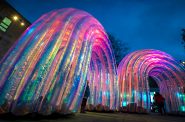Gabriele Munter’s “Green House, Murnau”

Gabriele Münter (German, 1877-1962) The Green House, Murnau, 1911 Oil on canvas 34 3/4 x 39 1/2 in. Gift of Mrs. Harry Lynde Bradley M1977.127 Photo by P. Richard Eells
Maybe the right angles the house imposes on a tilting mountain landscape say something about human intrusion, but any hint of narrative ends there. Münter tells no stories in this painting. She exploits a more or less identifiable landscape — a dirt road, a mountain, a fence (or perhaps a bolstered embankment; it doesn’t matter), a few trees, golden patches of grass or straw, gullies holding late-spring snow — to explore ideas about two-dimensional geometry and color.
She reduces the natural world to its essence in order to concoct a vivid, memorable image. The painting is about the painting, and about Painting.
A flat wash of light plays across the whole field and flattens things out. (Münter cares nothing for direction of light or perspective.) We perceive the painting as blocks of color, sternly delineated by bold brown/black lines (which of course do not exist in real life). These lines form a jumpy network within the frame, charged with odd, sharp angles. The squareness of the house is startling and tense amid such energized geometric chaos.
The roller-coaster profile of the mountains and trees on the horizon, the twist and tilt of the foreground surfaces and, especially, the suggestion of gear-like rotation rising from five wedges around the center of the painting add up to a carnival of implied motion.
This is not a calm painting. The hasty, urgent brushwork — note, especially, the odd little tornado just left of center, where the “dirt road” breaks through horizontal bands — adds to the general sense of excitation. Note also how the strokes run in the same direction in the big stretches of road; it’s almost as if the mud were flowing through the scene.
The first impression is of blocks of bold, simple color. But the complexity of mingling greens and yellows, purples and browns, browns and reds, greens and whites, purples and greens and browns, aquamarines and yellows and on and on within 21 distinct color fields become apparent within a few moments.
The longer you look, the more you see within the blocks. You also begin to see the relationships among the blocks of color, as in the thoughtful progression from green grass to yellow-green straw to blue-green house to purple mountain’s majesty.
Perhaps  Münter’s coloration was quick and intuitive, but it was by no means random. She had a canny eye and knew how to engage and hold the viewer’s eye.
Münter’s coloration was quick and intuitive, but it was by no means random. She had a canny eye and knew how to engage and hold the viewer’s eye.
Green House, Murnau is part of the Bradley Collection within the Milwaukee Art Museum.
Print out this story and present it at the admissions desk for a $2 discount.
Art
-
Winning Artists Works on Display
 May 30th, 2024 by Annie Raab
May 30th, 2024 by Annie Raab
-
5 Huge Rainbow Arcs Coming To Downtown
 Apr 29th, 2024 by Jeramey Jannene
Apr 29th, 2024 by Jeramey Jannene
-
Exhibit Tells Story of Vietnam War Resistors in the Military
 Mar 29th, 2024 by Bill Christofferson
Mar 29th, 2024 by Bill Christofferson























I visited the museum for the first time last Saturday. This was perhaps the most memorable painting there, for me. I was struck by how vibrantly alive the house felt, as if the entire landscape existed only for its benefit and amusement. The house felt supremely important, all-knowing, mischevous and slightly malevolant. It also felt kindly and protective over those savvy viewers who understood its power. It shimmered between this world and the next. Of all the paintings by this artist, this one was clearly the best. I wished I could have purchased a print of it. I loved the entire museum, was enthralled by the outsider art exhibit and purchased a book to drool over later. Will definitely return again and again.
Dear Karen,
Thanks so much for commenting. You’ll note that I and others have written quite a few essays about works in the MAM permanent collection. Do have a look. We’re proud of those things. — Strini